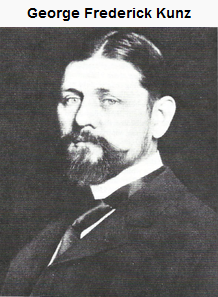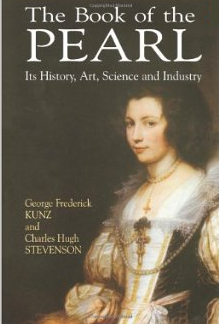 As many of you know, G. Frederick Kunz was one of the most influential gemologists of the 19th and 20th centuries. Among his many achievements, he and his friend Charles Hugh Stevenson wrote “The Book of the Pearl, the History, Art, Science and Industry of the Queen of the Gems” which appeared in 1908.
As many of you know, G. Frederick Kunz was one of the most influential gemologists of the 19th and 20th centuries. Among his many achievements, he and his friend Charles Hugh Stevenson wrote “The Book of the Pearl, the History, Art, Science and Industry of the Queen of the Gems” which appeared in 1908.
I thought you might be interested to read what Kunz says about pearl and bead stringing and the skills of pearl and bead stringers I’ve tried to break the text into shorter paragraphs, so the breaks are mine and are there for readability. The text is entirely Kunz.
This book is an indispensable component of any gemologist library and fortunately for us, it appears to have gone off copyright and is therefore freely available. Here a direct link to “The Book of the Pearl” on ebooksread.com where it’s available in several formats.
Here is Kunz on pearl stringing.
Earliest Strung Pearl Necklace
 We have no record as to when the first pearl necklace was strung or have we a definite record of the first use of silk for stringing a necklace. The earliest illustration that we have been able to obtain of the use of pearls in the form of a necklace is the one from Susa, in which the pearls were secured with gold. A Syrian necklace dating about one or two centuries before Christ, was strung by means of a bronze wire. We will endeavor to give a few instructions for stringing pearls.
We have no record as to when the first pearl necklace was strung or have we a definite record of the first use of silk for stringing a necklace. The earliest illustration that we have been able to obtain of the use of pearls in the form of a necklace is the one from Susa, in which the pearls were secured with gold. A Syrian necklace dating about one or two centuries before Christ, was strung by means of a bronze wire. We will endeavor to give a few instructions for stringing pearls.
Pearl Stringing is an Art – Selecting and Grading Pearls
Pearl stringing is an art, easy as the instructions for stringing pearls may seem, and it is interesting to note the precision, care, and delicacy with which the pearl stringer performs his task. The first step of instructions for stringing pearls is to grade the pearls according to their size and color, so that they may produce the best possible effect. The largest and finest pearl is placed in the center; alongside of this, on each side, are laid the two pearls next in size which are the most nearly alike in form and hue; and so on to the end of the necklace. This grouping required both experience and judgment, and is of great importance in the instructions for stringing pearls, since the value of the pearls is often considerably enhanced by a proper arrangement. A skillful stringer is able to grade them so cleverly that only a trifling difference will be found in the weight of the two halves of a necklace.
Pearl Stringing is an Art – Knotting Between Pearls
Another aspect of instructions for stringing pearls consists in securing the end pearl by a knot to the diamond, pearl, or other clasp which may be used. When a necklace is being strung, the thread is passed through the metal eye, or pearl, or other object that serves as a clasp.
It is then tied with one knot, passed through the next pearl, and knotted between the second and the third, thus making the joint doubly secure. The other pearls are then strung in their order, a knot being placed after each fifth, fourth, third, or second pearl, or, should there not be enough to give a proper length to the necklace, between each single pearl. The deftness with which the knot is tied so as not to hold the pearl too tightly, and risk the breaking of the thread, and the precision with which forty, fifty, and even sometimes several hundred knots are made on a single string, is a pleasing operation to witness when learning instructions for stringing pearls, and requires the greatest care and nicety of touch. If knots are made frequently between the pearls, there is less danger of losing them should the thread break, as only one or two can fall off; sometimes, indeed, when the drill holes are very small, the silk thread, waxed or unwaxed, fits so closely that the pearl does not become detached even when the thread breaks.
* * *
Notice that Kunz describes the selection of pearls for a graduated pearl necklace, a type of necklace that is somewhat old fashioned to our eyes today. Nevertheless, he is correct in essentials, that is the selection of pearls is one of the major tasks associated with putting together a pearl necklace and is in fact one of the quality factors by which we judge a pearl necklace.
I’d also point out that while knotting materials have changed, the basic components for stringing between pearls have not. The competent pearl and bead stringer must know how to attach or in Kunz’s word “secure” a necklace to a clasp and whether we knot between 20 or 100 beads knotting still requires what Kunz called “deftness…and nicety of touch.
It’s pleasing to recall the respect this giant of gemology had for pearl and bead stringers and I thought I’d point it out to you.

